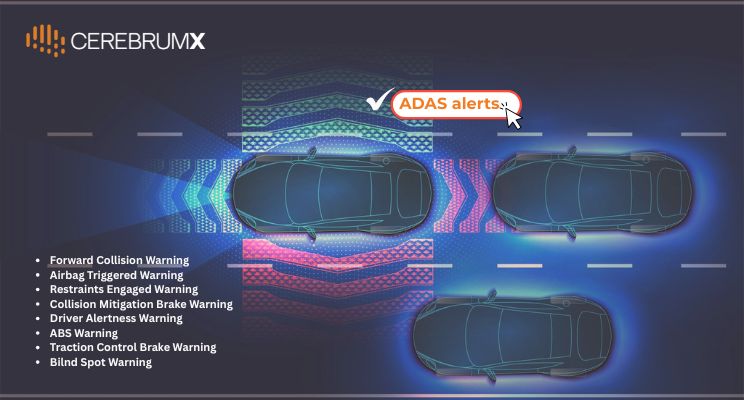Fleet safety is no longer a passive checklist—it’s an active, real-time operation powered by smart systems and intelligent data. And at the heart of this evolution lies the synergy between Advanced Driver Assistance Systems (ADAS) and embedded vehicle data. Together, they form a feedback-rich safety network for fleets, that not only detects risks but also enables immediate response and long-term behavioral improvements.
But while many fleets are equipping vehicles with ADAS capabilities, the true impact of these systems depends on the quality of data they work with—and that’s where the difference between embedded data and dongle-based telematics becomes critical.
ADAS Is Only as Good as the Data That Powers It
ADAS technologies—ranging from lane departure warnings to forward collision avoidance and adaptive cruise control—are designed to prevent accidents before they happen. They do so by constantly interpreting driving conditions, vehicle behavior, and surroundings to either alert the driver or intervene directly.
However, the effectiveness of ADAS doesn’t stop at detection. Fleets need to capture, interpret, and respond to ADAS-triggered events in real-time to extract full safety value. This is where embedded vehicle data becomes indispensable. Unlike aftermarket dongles that often lag or miss granular insights due to external dependencies, embedded systems provide native, high-resolution data directly from the vehicle’s core network of sensors and control units.
Real-Time Risk Detection Requires Real-Time Data
Let’s take lane departure alerts, for example. Embedded data enables instant detection of a deviation and ties it to precise vehicle telemetry—speed, turn signal usage, driver response time. This contextual awareness allows fleet managers to distinguish between avoidable errors and situational necessities, helping refine driver coaching without overgeneralizing behavior. With dongles, the latency in data transmission or atrial
With dongles, the latency in data transmission or partial access to onboard systems can result in delayed or incomplete event capture, eroding both trust and usability. Fleets relying on dongles often receive ADAS-triggered alerts too late to act meaningfully—or miss them entirely.
ADAS + Embedded = Collision Avoidance in Action
One of the most tangible benefits of ADAS is forward collision warning and automatic emergency braking. When a threat is detected, the vehicle reacts autonomously—but the event must still be logged, reviewed, and acted upon by fleet operators.
Embedded telematics makes this seamless. It captures data the moment the ADAS engages, logs the vehicle’s speed, proximity to the object, braking pressure applied, and the time to collision – all in real time. This high-fidelity insight is vital for reconstructing near misses, reducing liability, and tailoring risk-based training programs. Dongle-based setups often rely on accelerometer-triggered logic to approximate these events, which can misinterpret or oversimplify what actually occurred.
The Safety Loop: From ADAS Event to Actionable Insight
What truly sets embedded data apart is its ability to close the safety loop—not just capturing ADAS events, but immediately translating them into actionable intelligence. The process begins with the detection phase, where ADAS identifies a risky situation, such as an unsafe following distance. Embedded systems then step in to capture the full event stream in real-time, including critical surrounding vehicle data and sensor inputs, providing instant insights into the context of the event.
This information is immediately relayed to fleet managers through real-time alerts, allowing for swift awareness and response. Over time, the data is aggregated and analyzed to map patterns in driver behavior, offering a deeper understanding of recurring safety risks. Equipped with these insights, fleets can take preventive action by implementing targeted coaching, adjusting operation policies, or redesigning routes – ultimately transforming reactive responses into proactive safety strategies.
Dongles can only partially enable this flow due to limited access to proprietary ADAS signals and inconsistencies in data transmission.
Why Embedded Data Future-Proofs Fleet Safety
ADAS and embedded telematics are both deeply integrated with the vehicle’s internal architecture. When they work together natively, fleets benefit from zero lag, zero signal loss, and maximum context. This becomes even more important as ADAS features grow more complex with the adoption of AI, sensor fusion, and predictive modeling.
Dongle-based solutions, being externally mounted and retrofitted, simply can’t keep up with the pace or depth of modern in-vehicle systems. As safety becomes a data-driven discipline, embedded connectivity ensures fleets are not reacting to yesterday’s risks—but actively preventing tomorrow’s.
Driving Safer Fleets with CerebrumX
At CerebrumX, we understand that the path to safer fleets lies at the intersection of intelligent systems as well as intelligent data. That’s why we offer both dongle-based and embedded telematics solutions for you to choose from that suit your business needs best.
Ready to see what real-time ADAS insights can do for your fleet? Let’s talk about the right data fit for your operations.

